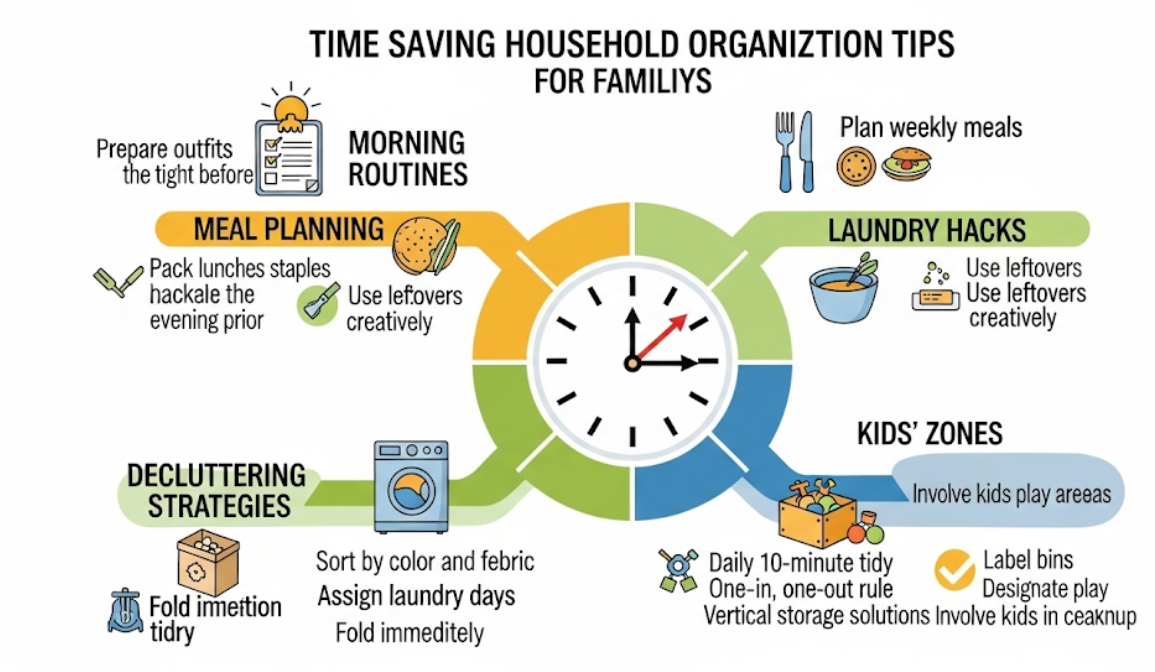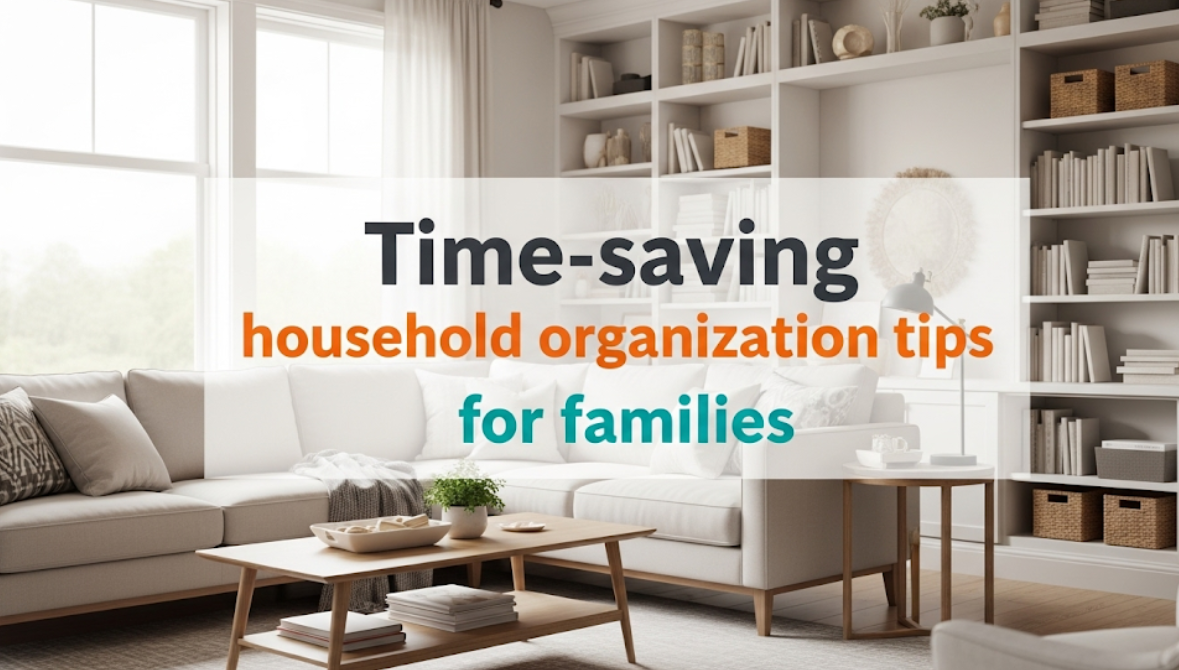Time-Saving Household Organization Tips for Families | Transform Your Home Into an Efficient Haven
Sometimes, trying to manage family life can seem like you are spinning plates whilst riding a unicycle. Shuttling kids to and from school, juggling food shopping, laundry loads and incessant homework assignments – many parents admit that they sometimes wish there were something akin to a magical formula to keep everything moving like clockwork. The good news? There is, and it doesn’t involve hiring a professional organizer or spending thousands on storage solutions.
Family organization is SO much more than being organized and having a Pinterest-ready home. It’s all about developing systems that save time, lower your stress levels, and make it so everyone in your house knows where things go. Having your home run like a well-oiled machine will provide you more time making memories with loved ones and less time searching for lost items.
In this comprehensive guide, you will discover tried-and-true methods real families use to simplify daily living, efficiently organize every room in your house, and minimize the pain of cleaning while actually spending time with family. From toddler toys scattered everywhere to teenagers who treat their room like storage units, these practical tips will help you turn the chaos of your household into calm efficiency.
Your Home’s Mission Control: Creating A Family Command Center
Every organized family needs a centralized location to keep schedules, daily essentials and important information. Picture this as your family’s headquarters.
Setting Up Your Command Station
Choose a high-traffic spot where family members congregate naturally, such as:
- Kitchen wall near the entrance
- Mudroom or entryway
- Hallway connecting main living areas
- Side of the refrigerator
Essential Command Center Components:
- Large family calendar (dry erase or cork board style)
- Mail sorter with labeled slots
- Individual key hooks for all family members
- Phone charging station
- Important document holder
- Daily task checklist board
Digital vs Physical Organization Systems
| Digital | Physical |
|---|---|
| Shared Google Calendar | Wall-mounted calendar |
| Family organizing apps | Bulletin Board displays |
| Digital to-do lists | Whiteboard task lists |
| Cloud document storage | Physical filing system |
| Online meal planning | Paper meal planning charts |
Pro Tip: Use both systems in unison! Employ digital tools for long-term planning and physical displays for daily reminders that everyone can see at a single glance.
Room-by-Room Organization Strategies
Kitchen Organization That Actually Works
The kitchen is the heart of most homes, which makes it essential that it functions well for every family member.
Counter Space Management:
- Keep only daily essentials on counters (coffee maker, etc.)
- Use vertical storage through wall-mounted racks
- Install pull-out drawers in lower cabinets
- Create designated zones for coffee, cooking and cleaning
Pantry Organization System:
- Keep like items together (canned goods, snacks, baking supplies)
- Use clear containers for cereals, pasta and bulk items
- Label everything with expiration dates
- Install door organizers for spices and small items
- Store kid-friendly snacks at children’s eye level
Refrigerator Zones:
- Top Shelf: Leftovers and grab-and-go items
- Middle shelves: Dairy and main meal ingredients
- Bottom shelf: Raw meats in contained area to catch spills
- Crisper drawers: Fruits and vegetables separately
- Door: Condiments, dressings, and beverages
Smart Solutions for Busy Family Living Rooms
A living room gets heavy use from every family member, and thoughtful organization makes this manageable.
Quick Daily Reset Strategy:
- Use attractive baskets for toy consolidation
- Ottoman storage for blankets and games
- Install floating shelves for books and decorations
- Keep a basket for items that belong in other rooms
Media Organization:
- Hide electronics clutter with cord management boxes
- Store controllers & remotes in a designated place
- Organize DVD/game storage in labeled containers
- Establish a tech charging station away from seating areas
Bathroom Organization for Multiple Users
Shared bathrooms can turn into battlegrounds without proper organization!
Morning Routine Streamlining:
- Individual caddies for everyone’s toiletries
- Install hooks at appropriate heights for each user
- Organize medicine cabinet with safety locks for harmful substances
- Use drawer dividers for hair ties, bobby pins, razors
- Add hanging caddies and corner shelves to keep shower organized
Linen Closet Efficiency:
- Store fitted sheets inside their matching pillowcase
- Use shelf dividers to keep towels from toppling over
- Store excess toiletries in clear plastic bins
- Place cleaning supplies on high shelves that kids cannot reach
Time-Saving Laundry Systems
For most families, laundry is one of the more dreaded and time-consuming household chores, however there are great systems to help reduce your laundry time!
The Three-Basket Method
Sorting at the Source:
- Place three baskets in each bedroom: whites, darks and delicates
- Teach family members to sort when undressing
- Empty baskets when full, no fixed schedule needed
- Use mesh bags for socks and small items
Streamlined Washing and Drying Process
Daily Laundry Schedule:
- Monday: Towels and linens
- Tuesday: Dark clothes
- Wednesday: Light/white clothes
- Thursday: Delicates and special items
- Friday: Kids’ clothes and uniforms
- Saturday: Household items (curtains, rugs)
- Sunday: Catch-up day
Folding and Distribution System:
- Fold clothes immediately after drying to avoid wrinkles
- Give each family member their own basket for clean clothes
- Teach kids to put away their own clothing
- Hang anything that wrinkles the same day
- Use bedroom baskets for basics like socks and underwear
Morning and Evening Routines
Daily life thrives on consistent routines. Once everyone knows what to expect, mornings are less chaotic and evenings much more relaxed.
Morning Routine Optimization
The Night-Before Preparation:
- Lay out clothes for tomorrow
- Pack backpacks and work bags
- Prepare breakfast items
- Charge all devices
- Review the next day’s schedule
Morning Station Setup:
- Designate spots for packed lunches
- Keep breakfast supplies easily accessible
- Create a landing zone near the entrance for grab-and-go items
- Post kid-level morning checklists
Evening Wind-Down Systems
Family Reset Hour (30 minutes before bed):
- Everyone picks up 10 items and puts them back where they belong
- Reset kitchen and prepare for the next morning
- Select tomorrow’s clothes
- Place backpacks by the door
Weekly Preparation Sessions:
- Sunday afternoon family planning meeting
- Meal prep for the upcoming week
- Discuss schedules and transportation with everyone
- Gather any work or school supplies needed
Smart Storage Solutions for Every Budget
Good organization doesn’t require expensive custom storage units. Creative repurposing can be just as functional.
DIY Storage Ideas That Work
Repurposing Common Items:
- Shoe boxes for organizing supplies or small items
- Ice cube trays for jewelry, screws, or small parts
- Cereal boxes covered in decorative paper for magazine storage
- Baby food jars for small parts in garage and craft rooms
- Tension rods for hanging cleaning supplies under sinks
Budget-Friendly Organization Products:
- Clear containers from dollar stores for pantry organization
- Wooden crates from craft stores for rustic storage
- Over-the-door shoe organizers for multiple uses
- Drawer organizers for every room
- Command hooks for temporary hanging solutions
Maximizing Small Spaces
Vertical Storage Strategies:
- Install shelves up to the ceiling in closets
- Use wall space behind doors for hanging organizers
- Stack storage containers with clear labels
- Hang items from garage/basement ceiling
- Maximize space under beds with rolling bins
Multi-Functional Furniture:
- Ottoman storage benches for seating and toy storage
- Bed frames with built-in drawers
- Coffee tables with hidden compartments
- Dining benches with lift-up seats
- Nightstands with multiple drawers and shelves
Technology Tools for Family Organization
You have an amazing arsenal of organizational tools in your smartphone, but unless everything is seamlessly integrated and your whole family is on board with using them, you won’t gain much from technology.
Essential Apps for Family Coordination
Calendar and Scheduling:
- Google Calendar for shared family schedules
- Cozi Family Organizer – comprehensive family management app
- TimeTree for color-coded family scheduling
- Any.do for shared task lists and reminders
Meal Planning and Shopping:
- Plan to Eat for meal planning and grocery list generation
- AnyList for shared family grocery lists
- Mealime for quick meal planning with dietary restrictions
- BigOven for recipes and meal planning
Household Management:
- Tody for cleaning schedule management
- Sweepy for assigning and tracking chores
- HomeRoutines for establishing family routines
- FamCal for shared family calendar and activity integration
Setting Up Digital Organization Systems
Cloud Storage for Family Documents:
- Create organized folders by family member
- Scan important papers and store digitally
- Share access with spouse/partner
- Regular backup of important photos/files
- Organize by categories: medical, school, finances, warranties
Automated Reminders and Tasks:
- Set up recurring reminders
- Create location-based reminders (grocery store, school pickup)
- Use voice assistants for hands-free list management
- Sync calendars across all family devices
Involving Kids in Organization Systems
Teaching children to be organized is one of the best life skills you can provide, and it also makes your life as a parent much easier.

Age-Appropriate Organization Tasks
Ages 3-5:
- Put toys in designated bins
- Place dirty clothes in hamper
- Set napkins and cups on table for dinner
- Put books back on low shelves
Ages 6-9:
- Make their beds daily
- Organize school supplies in backpack
- Sort clean silverware from dishwasher
- Keep bedroom floor clear of clothes and toys
Ages 10-13:
- Manage their own laundry sorting
- Pack school lunch with supervision
- Organize school papers and homework
- Help with grocery shopping and list-making
Ages 14+:
- Do their own laundry completely
- Manage their own schedule and commitments
- Help with meal planning and preparation
- Organize shared family spaces
Making Organization Fun for Children
Gamification Strategies:
- Create timed cleaning challenges
- Use colorful labels with pictures for non-readers
- Play upbeat music during family cleanup time
- Reward consistency in organization, not perfection
- Race to see who can put away 10 items first
Visual Organization Tools:
- Use clear bins so kids can see contents
- Label with both words and pictures
- Color-code items by category or family member
- Create visual schedules with pictures of tasks
- Use charts to track organization goals
Meal Planning and Kitchen Organization
Effective meal planning can save families hours each week while also reducing food waste, which represents a significant portion of grocery spending.
Weekly Meal Planning Strategy
The Four-Step Planning Process:
- Check family calendar for activities and late nights
- Take inventory of pantry and plan around what you have
- Choose 2-3 new recipes and 4-5 family favorites
- Create a comprehensive shopping list organized by store sections
Meal Prep Categories:
- Freezer meals for busy weeks
- Slow cooker meals for hectic school days
- Quick 15-minute meals for last-minute schedule changes
- Weekend family cooking projects
- Leftover transformation recipes to reduce waste
Kitchen Storage for Busy Families
Snack Station Organization:
- Create individual snack bins for easy access
- Pre-portion snacks into individual containers
- Keep healthy options at eye level
- Store special treats separately
- Label bins with contents
Cooking Efficiency Setup:
- Store pots and pans near the stove
- Group baking supplies together with clear labels
- Keep spices within arm’s reach of cooking area
- Designate space for knives and cutting boards
- Set up a coffee/tea station for quick morning access
Seasonal Organization and Maintenance
Like any system, organization systems need maintenance – review them seasonally to keep them working effectively.
Quarterly Organization Reviews
Seasonal Decluttering Schedule:
- Spring: Clothing swap, outdoor equipment organization
- Summer: Toy rotation, activity supply organization
- Fall: School supply refresh, winter clothing preparation
- Winter: Holiday decoration storage, indoor activity setup
Monthly Maintenance Tasks:
- Update and sync all family calendars
- Deep clean one major area of the house
- Assess which systems are working well
- Adjust storage solutions that aren’t performing
- Include children in reviewing their organization systems
Holiday and Special Event Organization
Holiday Storage Solutions:
- Use clearly labeled bins for holiday decorations
- Organize by location or type of decoration
- Create a designated gift-wrapping supply area
- Develop inventory lists for each storage box
- Use vacuum storage bags for bulky seasonal items
Birthday and Special Event Planning:
- Maintain a gift closet with wrapping supplies
- Store party supplies in labeled bins
- Keep a running list of gift ideas for family members
- Create template checklists for recurring events
- Designate storage area for special occasion decorations
Troubleshooting Common Organization Challenges
Even the best organization systems face problems. Here are the most common issues families encounter and their solutions.
When Organization Systems Break Down
Common Problems and Solutions:
Problem: Family members don’t follow the system
Solution: Evaluate if the system is too complicated and simplify it. Involve family members in designing new, user-friendly systems.
Problem: Clutter accumulates faster than you can organize
Solution: Implement a “one in, one out” rule and schedule regular 15-minute decluttering sessions.
Problem: Systems work initially but gradually fall apart
Solution: Build maintenance time into your schedule with weekly and monthly system check-ins.
Problem: Different family members have different organizational styles
Solution: Create flexible frameworks that allow individual customization without compromising the overall system.
Maintaining Motivation for Long-Term Success
Strategies for Sustainable Organization:
- Start small and gradually add new systems
- Celebrate family organization victories
- Take before and after photos to see progress
- Focus on time saved rather than perfection
- Schedule seasonal system reviews to prevent stagnation
Building Organization Habits:
- Link new organization habits to existing routines
- Use the two-minute rule – if it takes less than two minutes, do it now
- Practice the one-touch rule (handle things once when possible)
- Create visual reminders until habits become automatic
- Be patient with the process – habits take 21-66 days to form
Final Thoughts: Your Family’s Organization Journey
Creating an organized family life isn’t about achieving perfection or maintaining a house clean enough for magazine pages. It’s about developing systems that work for your specific family lifestyle, reduce daily stress, and free up time for what truly matters – spending quality time together.
The key to lasting success lies in starting small, involving every family member, and adapting your systems as your family grows and changes. Remember that organization is a skill that improves with practice, and what works for one family may need modification to work for yours.
As you implement these strategies, focus on progress rather than perfection. There will be days when systems work like magic and days when life happens and things get off track. That’s completely normal and okay. The goal is to have systems that can be easily reset when needed.
The time invested in family organization will pay dividends in reduced stress and increased quality time with your children – children who will benefit from learning these valuable life skills. Start with mastering one area or system before moving to the next, and gradually build your organized home throughout your space. Soon, your home will transform from chaos to calm, creating more time for the moments that truly matter in your family’s life.
The journey to organized family living is exactly that – a journey that continues throughout your family’s lifetime. Embrace the process, be patient with yourself and your family members, and remember that every small organizational improvement is a step toward a more peaceful, efficient home life.




